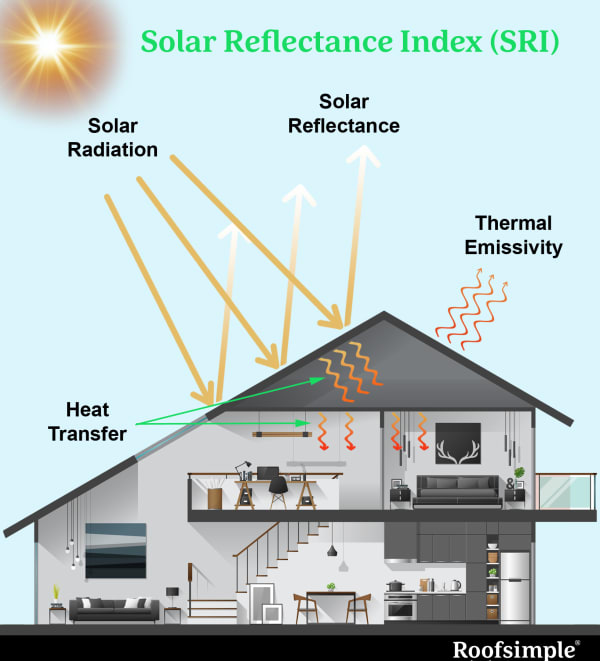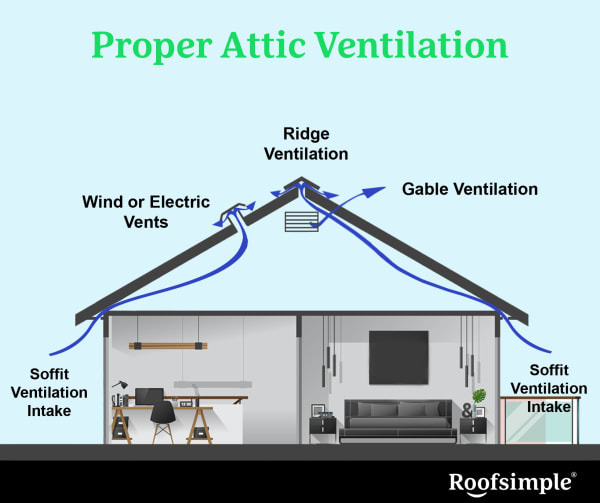Energy-Efficient Roofs Explained: What They Are & What to Look For

Energy efficiency in the home has been a popular topic for many years. Home appliances, HVAC systems, energy-saving windows, and even LED light bulbs are all promising to save energy and cut costs.
But did you know that an energy-efficient roof is one of your best resources for saving energy? An energy-efficient roof can save you hundreds of dollars every year.
Let’s examine energy-efficient roofs and how your roof can help you lower your energy bill and keep you more comfortable in the process.
- What makes a roof energy efficient?
- Do energy-efficient roofs really save you money?
- What type of roof is the most energy efficient?
- Are they more expensive?
- What are the pros and cons? Is there a difference between an energy-efficient roof and a “cool roof”?
- Is there a difference between energy-efficient and cool roofs?
What Makes a Roof Energy Efficient?
According to GreenBuildingAlliance.org, 90% of roofs in the United States are poorly designed and built with dark, non-reflective materials that absorb rather than reflect heat.
Rooftop temperatures can get 90 to 100 degrees hotter than the outside air temperature. With a dark, heat-absorbing roof, this heat transfers into your attic and, ultimately, your home.
While good insulation offers some relief, it doesn’t stop the transference of heat from the roof top to the attic. And when your attic is overheated, that excess heat will transfer into your home and make the A/C work harder than it should.
Two factors impact a roof’s ability to stop this transference of heat: solar reflectance and ventilation.
Solar Reflectance Index

The Solar Reflectance Index measures a roof’s ability to reject solar heat (solar reflectance) and release any heat that is absorbed (thermal emissivity).
The higher the SRI number the better.
Lawrence Berkeley National Laboratory found that raising the SRI from 25 to just 40 can lower the surface temperature of your roof by more than 13 degrees. That could translate to a 15–20% savings on your energy bill.
Lighter colors reflect heat better than darker colors, and certain coatings can add even more reflectivity. But the key to an energy-efficient roof is that it will reflect the sun’s radiation away from the house.
That means less heat gets transferred to the attic. And a cooler attic means less heat gets transferred to your home.
Solar reflectance might not seem as important in colder climates, but even if you live where summers are short, the savings can add up.
Ventilation
Another factor for keeping your roof cool is ventilation.
Good ventilation keeps any heat that’s transferred to the attic from building up. If the temperature outside is in the 90’s, attic temperatures can get as high as 160 degrees.
And that heat has to go somewhere.
Without proper ventilation, it will transfer to the inside of your home. And if temperatures get too extreme, it won’t just raise your electric bill — it can actually damage your roof.

Static vents, wind powered vents and eclectic vents are the three main types of roof vents used in residential roofing. Each has its pros and cons.
Which vents you choose, and how much ventilation you need, is a question your service roofer can answer more precisely. A general rule of thumb is to shoot for a ratio of 1:300 (1 square foot of ventilation for every 300 square feet of roof surface).
Do Energy-Efficient Roofs Really Save You Money?
Energy-efficient roofs pay for themselves. They can lower your utility bills by as much as 25 percent. For an average home, the savings can add up to $300 to $500 a year.
Some states and municipalities offer rebates for cool roofs. You can even earn a tax credit through the Energy Star rating program.
What Type of Roof Is the Most Energy Efficient
A lot of roofing materials have been rated by Energy Star, but there are definite differences from one type of roof to another. Here’s a quick review of what you need to know.
Types of Roofs
Metal roofing is by far one of the best choices you can make for your roof in general. They’re the most energy-efficient roof for residential installations, can last more than 50 years, and require very little maintenance.
Metal roofs are very reflective, which is why they get so hot to the touch. Much of the sun’s energy is coming right back off the roof. That means they have a high SRI.
And they can be covered with special coatings to give them an even higher efficiency rating.
Tile roofs are also a good energy-efficient roof choice. They can be made from slate, clay or concrete. They can be pre-treated to maximize heat reflectivity. And if you’ve already installed them, don’t worry. They can be treated with reflective coatings even after installation.
Tile roofs also allow air to flow under the tiles which adds to their ability to release any heat they do absorb.
Asphalt shingles are the most common type of roofing material used on homes. Traditionally, they’re also one of the most non-reflective and heat-absorbent roofing options available.
Fortunately, that has changed in recent years. Advances in roofing technology means asphalt shingles are more efficient than ever before.
Today, manufacturers are creating new lines of asphalt shingles with solar-reflecting granules that raise the SRI value and even extend the life of the roof by keeping surface temperatures low.
Owens Corning’s “Cool Roofing Collection” is a good example. It includes shingles with a reflectance value over 20. They even come in darker colors that are normally associated with low solar reflectance values.
Bear in mind, many asphalt shingles don’t have these energy-efficient features. Without the solar-reflecting granules, an asphalt shingle roof may be as much as 100 degrees hotter. And that heat’s going to transfer into your attic and then into your home.
Energy Star Rated Roofs
Not all roofs are created equal. Ask your roofer what the Energy Star rating is for the material you’re choosing. A good service roofer will usually deal with several manufacturers and can help you find the right product for your needs.
Are Energy-Efficient Roofs More Expensive?
Energy-efficient roofs may be more expensive initially, but they usually pay for themselves over time.
For example, a metal roof could lower your energy bill by as much as 40 percent in the summer. Cool roofs can also save money with rebates, incentives, and tax credits.
An energy-efficient roof can also save you money by extending the life of your roof. And since your HVAC system doesn’t have to work as hard to cool your home, it will last longer too.
So What are the Benefits of an Energy-Efficient Roof?
An energy-efficient roof can do more than just save you money on your energy bill. Here are just a few of the other ways an energy-efficient roof can pay you back:
- It lowers maintenance costs.
- It adds to your property value or resale value.
- It extends the life of your roof
- It extends the life of your HVAC system.
- It makes your home more comfortable.
- It improves indoor comfort for spaces that aren’t air conditioned, such as garages or covered patios.
- It looks as good or better than a non-energy-efficient roof.
- It lowers peak electricity demand, which can help prevent power outages.
It can even be good for the environment — by reducing the amount of energy needed to cool buildings, energy-efficient roofs reduce power plant emissions.
Is There a Difference Between an Energy-Efficient Roof and a Cool Roof?
The Department of Energy defines a cool roof as “one that has been designed to reflect more sunlight and absorb less heat than a standard roof.” So, basically any energy-efficient roof could qualify as a cool roof.
However, the term “cool roof” is often associated with flat roofs or commercial installations. Cool roofs typically go over an existing roof by adding a reflective coating. That’s not as easy to do over a conventional shingles.
In cities where most of the buildings and homes have flat roofs, cool roofs can make a big difference. They can actually reduce local air temperatures (sometimes referred to as the urban heat island effect).
Energy-Efficient Roofs: The Smart Choice
Energy-efficient roofs (including cool roofs) are becoming the norm in roofing. Some cities even require all new roofing to meet some solar reflectance minimum.
But even if it’s not required, the benefits of an energy-efficient roof are worth considering before you pick your next roof.